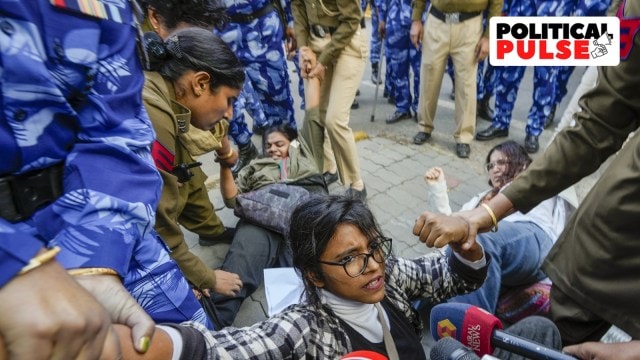In Sambhal, UP government considers bringing back an old tactic: Public shaming of protesters
The Yogi Adityanath government first adopted this strategy in the aftermath of the anti-CAA protests. Then it ran into legal challenges.
 Police detain protesters during a demonstration against UP Government over Sambhal violence, at UP Bhawan in New Delhi. (PTI Photo/Vijay Verma)
Police detain protesters during a demonstration against UP Government over Sambhal violence, at UP Bhawan in New Delhi. (PTI Photo/Vijay Verma) The Uttar Pradesh government’s plan to put up posters with photographs of more than 100 protesters allegedly involved in the Sambhal violence on November 24 is not the first time the Yogi Adityanath administration has considered naming and shaming people accused of damaging public properties during protesters.
The government first responded in this manner in the aftermath of the widespread protests in the state against the Citizenship Amendment Act (CAA) in 2020. On March 6, 2020, the UP government put up posters at major crossings in Lucknow containing the names, photographs, and addresses of 57 anti-CAA protesters identified through CCTV and other visuals. Among those shown in the posters were leading activists, including Congress leader Sadaf Jafar, Rihai Manch founder Mohammad Shoaib and Deepak Kabir, prominent Shia cleric Kalbe Sadiq’s son Kalbe Sibtain Noori, and retired IPS officer and activist S R Darapuri.
The accused were asked to pay compensation for allegedly damaging public properties during the protests. The government sought to recover Rs 1.55 crore from these protesters and warned them that their properties would be seized if they failed to pay up.
Three days later, the Allahabad High Court took suo motu cognizance of the incident and asked the Lucknow administration to remove the hoardings of those booked in cases of alleged vandalism, calling it an interference in their privacy.
The court listed the matter for hearing on March 16 but before that, the UP government moved the Supreme Court against the order of the High Court. The Supreme Court observed there was no law to support the government’s action but did not pass any interim order. Moving swiftly, the Adityanath government decided to come up with its own law to lay down the procedure to punish those guilty of damaging public property.
On March 15, the government issued an Ordinance to define the procedure and punishment in such cases and soon it was promulgated into the Uttar Pradesh Recovery of Damages to Public and Private Property Act, 2020, which the state Assembly passed in August.
With the matter still pending in courts, posters with the photos and details of the anti-CAA protesters came up again in public places on November 6. These posters declared them as absconders and announced a Rs 5,000 reward for information about them. These accused were booked under the Uttar Pradesh Gangsters and Anti-Social Activities (Prevention) Act, 1986.
In July 2021, the Supreme Court, while hearing a petition filed by one Parwaiz Arif Titu seeking to quash these notices, directed the UP government not to take action on earlier notices sent to the protesters for recovery of damages. In compliance, the government in February 2022 withdrew 274 recovery notices that were issued before it passed the new law on recovery of damages and assured that it would look into the matter as per the new law. Now, as per the new law, cases of recovery of damages are heard by a claims tribunal.
- 01
- 02
- 03
- 04
- 05































